The golden era of Hollywood glamour brought us some of the most sophisticated and timeless hairstyles that continue to captivate modern audiences.
If you’re searching for “33 Elegant 1930s Updo Hairstyles for Long Hair You Must Try,” you’ve discovered a treasure trove of vintage sophistication that transforms long locks into sculptural masterpieces.
This comprehensive guide walks you through the iconic finger waves, pin curls, victory rolls, and Marcel waves that defined an entire decade of elegance, along with modern adaptations that make these styles accessible for today’s special occasions, weddings, themed parties, or anyone wanting to channel old Hollywood glamour.
Each hairstyle in this collection showcases the artistry of 1930s coiffure, complete with detailed descriptions, styling techniques, and practical tips to help you recreate these stunning updos whether you’re a vintage enthusiast, bride-to-be, or simply someone who appreciates timeless beauty and wants to master the sophisticated charm of Depression-era elegance.
Contents
- 1 1. Classic Finger Wave Updo
- 2 2. Marcel Wave Chignon
- 3 3. Victory Roll Updo
- 4 4. Low Braided Chignon with Finger Waves
- 5 5. Pin Curl Crown with Low Bun
- 6 6. Side-Swept Wave Updo
- 7 7. French Twist with Finger Wave Front
- 8 8. Gibson Tuck with Waves
- 9 9. Double Victory Roll with Back Twist
- 10 10. Barrel Curl Updo
- 11 11. Rolled Chignon with Side Waves
- 12 12. Crown Braid Updo with Finger Waves
- 13 13. Low Side Chignon with Deep Part
- 14 14. Faux Bob Updo
- 15 15. Sculpted Pin Curl Updo
- 16 16. Twisted Halo Updo
- 17 17. Asymmetrical Wave and Curl Updo
- 18 18. Vintage Pompadour Updo
- 19 19. Rolled Sides with Center Bun
- 20 20. Finger Wave Bob Updo
- 21 21. Braided Crown with Loose Curls
- 22 22. S-Wave Updo with Side Accent
- 23 23. Reverse Roll Updo
- 24 24. Nested Pin Curl Updo
- 25 25. Wrapped Chignon with Finger Wave Accents
- 26 26. Triple Roll Updo
- 27 27. Diagonal Wave Updo
- 28 28. Vintage Beehive Foundation Updo
- 29 29. Waved Ponytail Updo
- 30 30. Crossover Twist Updo
- 31 31. Cascading Pin Curl Side Updo
- 32 32. Rolled Pompadour with Back Cluster
- 33 33. Braided Figure-Eight Updo
- 34 Styling Tips and Product Recommendations
- 35 Hair Type Considerations
- 36 Occasion-Specific Styling Guide
- 37 Maintenance and Longevity Tips
- 38 Accessories and Embellishments
- 39 Common Mistakes and Troubleshooting
- 40 Modern Interpretations and Adaptations
- 41 Conclusion
1. Classic Finger Wave Updo

The classic finger wave updo stands as the quintessential 1930s hairstyle that epitomizes the era’s sophisticated aesthetic.
This technique creates S-shaped waves close to the scalp that flow into an elegant low bun or chignon, offering a polished look that works beautifully for formal events and vintage-themed celebrations.
Styling Technique:
- Apply a generous amount of setting lotion or strong-hold gel to damp hair, ensuring even distribution from roots to ends.
- Create deep horizontal partings approximately one inch apart across the front and sides of the head.
- Use a fine-toothed comb to push the hair forward into a wave formation, then backward to create the opposite curve.
- Secure each wave with finger wave clips or bobby pins while the hair sets completely.
- Once dry, gather the remaining hair at the nape into a smooth low bun, securing with pins and finishing with hairspray.
Best For:
- Weddings, gala events, Great Gatsby themed parties, and formal occasions requiring vintage elegance.
- Hair length of shoulder-length or longer works best for creating substantial finger waves with enough length for an updo.
2. Marcel Wave Chignon
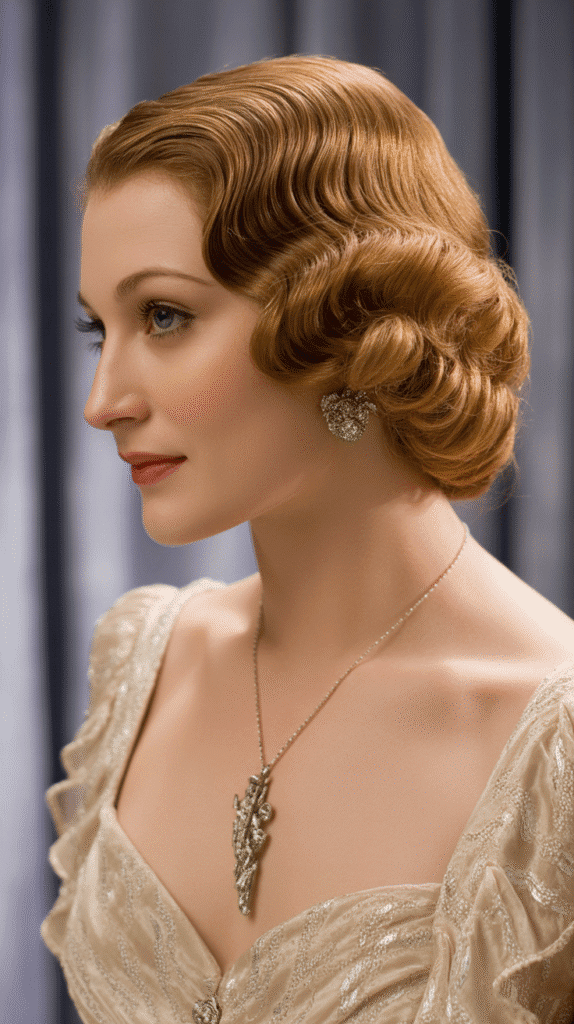
The Marcel wave chignon combines the heat-styled Marcel waves with a sophisticated twisted bun at the crown or nape.
Named after Marcel Grateau who invented the Marcel iron, this hairstyle creates deep, long-lasting waves that add volume and dimension before being swept into an updo.
Styling Process:
- Section hair into manageable portions, working with clean, dry hair for best results.
- Use a Marcel curling iron or modern alternative heated to appropriate temperature for your hair type.
- Create deep waves by clamping the iron and rotating it away from the face, holding for several seconds.
- Allow waves to cool completely in pin curls before brushing through to create continuous wave patterns.
- Gather the waved hair into a twisted chignon at the desired position, securing firmly with bobby pins.
- Set the entire style with strong-hold hairspray and smooth any flyaways with pomade.
Maintenance Tips:
- Sleep with a silk scarf to preserve waves overnight and extend the style’s longevity.
- Touch up with a curling iron on low heat if waves begin to drop throughout the day.
3. Victory Roll Updo
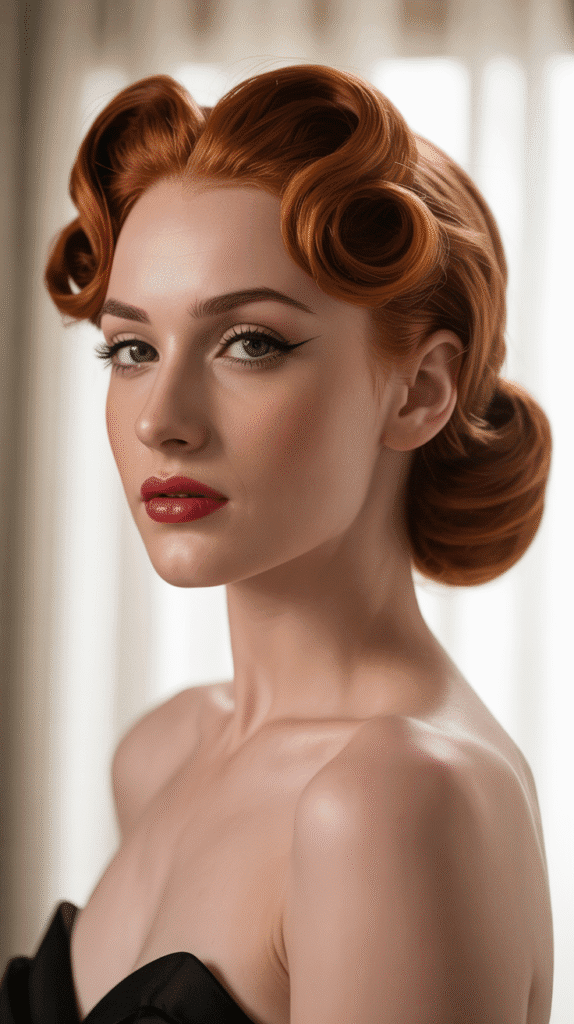
Victory rolls became iconic in the late 1930s and early 1940s, featuring rolled sections of hair that frame the face dramatically.
This updo variation incorporates victory rolls at the front with the remaining hair styled into a complementary bun or tucked arrangement.
Creation Steps:
- Start with completely dry, styled hair that has been set in curls or waves for better hold.
- Section off the front portions of hair on either side of a center or side part, typically two to three inches wide.
- Backcomb each section thoroughly at the roots to create volume and grip for rolling.
- Roll each section upward and inward toward the scalp, creating a tubular roll shape.
- Secure each victory roll with crossed bobby pins, ensuring they’re hidden within the roll.
- Style the remaining hair into a low bun, French twist, or pin curl arrangement at the nape.
- Finish with hairspray and add decorative combs or flowers for enhanced vintage appeal.
4. Low Braided Chignon with Finger Waves
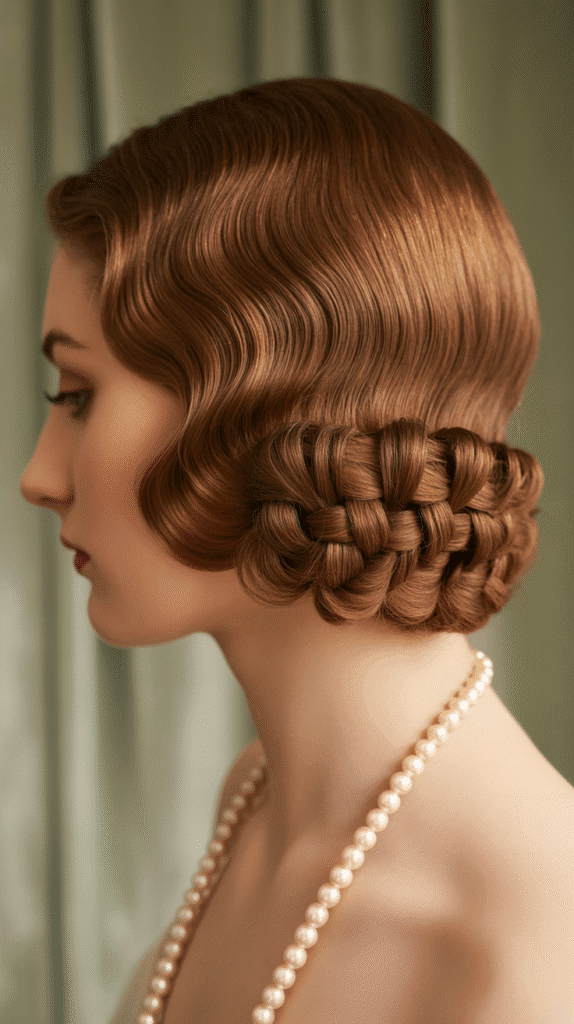
This sophisticated combination merges the smoothness of finger waves with the intricate texture of braiding.
The front showcases polished finger waves while the back features braids woven into a low chignon, creating an interesting contrast of textures.
Construction Method:
- Create finger waves across the front and side sections as described in previous styles.
- Part the remaining hair at the crown and divide into three equal sections for braiding.
- Execute French braids, Dutch braids, or standard three-strand braids depending on desired texture.
- Wrap the braids around each other at the nape, forming a circular chignon pattern.
- Tuck all ends underneath and secure with U-shaped pins for invisible hold.
- Blend the finger waves seamlessly into the braided section using pomade or gel.
Versatility:
- Adjust braid tightness for different looks—tight braids for formal events, looser braids for romantic occasions.
- Add ribbon woven through braids for colorful vintage flair perfect for garden parties.
5. Pin Curl Crown with Low Bun
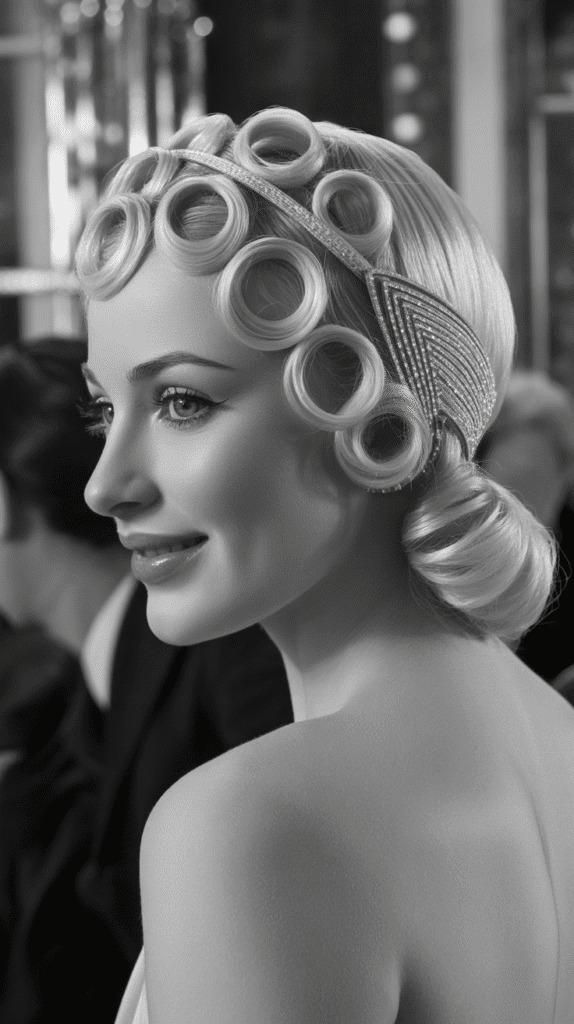
Pin curls dominated 1930s hairstyling as the foundation for many elaborate updos.
This style features visible pin curls arranged in a crown pattern around the head, with straight or waved hair gathered into a low bun at the nape.
Setting Instructions:
- Work with damp hair and apply setting lotion for maximum curl retention.
- Create small circular sections of hair, approximately one inch in diameter.
- Wind each section flat against the scalp in a spiral formation, alternating clockwise and counterclockwise directions.
- Secure each pin curl with two crossed bobby pins or curl clips.
- Allow hair to dry completely—at least four hours or overnight for best results.
- Carefully remove pins without disturbing curl formation, then arrange pin curls decoratively around crown.
- Gather nape hair into a smooth low bun, ensuring clean lines and polished finish.
Longevity:
- This style can last three to four days with proper nighttime protection using pin curls and scarves.
6. Side-Swept Wave Updo
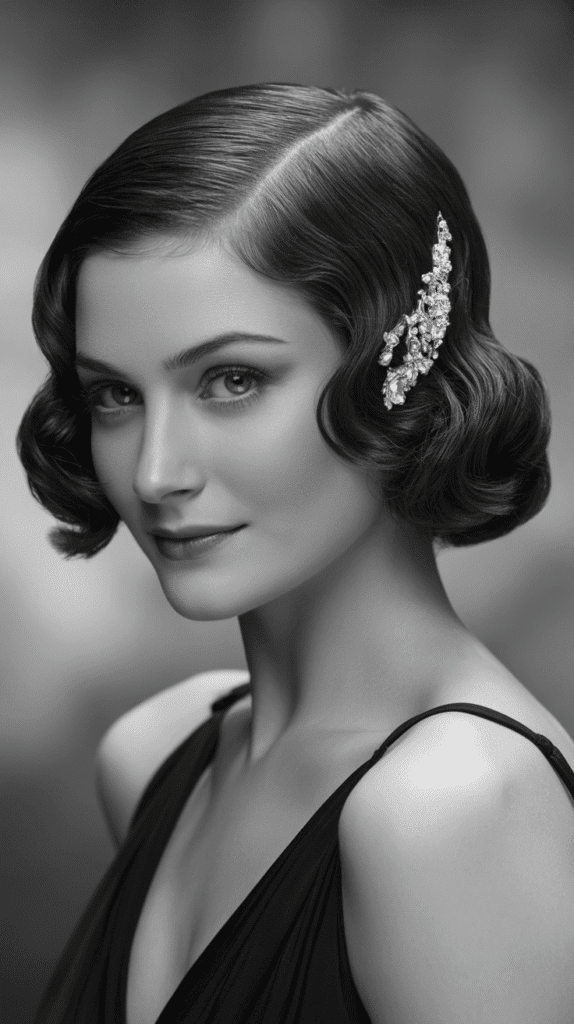
The side-swept wave updo epitomizes 1930s asymmetrical elegance, featuring deep waves that cascade from a dramatic side part before being gathered into a low-positioned updo.
This style showcases the face beautifully while maintaining the era’s characteristic sophistication.
Execution:
- Create a deep side part, positioning it approximately two inches from the natural center part line.
- Set the heavier side with finger waves or pin curls to create volume and movement.
- Style the lighter side sleekly against the head, using gel or pomade for high shine.
- Once waves are set and brushed through, sweep all hair to the opposite side of the part.
- Create a low side bun or twisted chignon just behind the ear on the lighter side.
- Allow some waves to frame the face softly on the heavier side before securing them into the updo.
- Use decorative pins, combs, or fresh flowers at the base of the updo for added glamour.
7. French Twist with Finger Wave Front
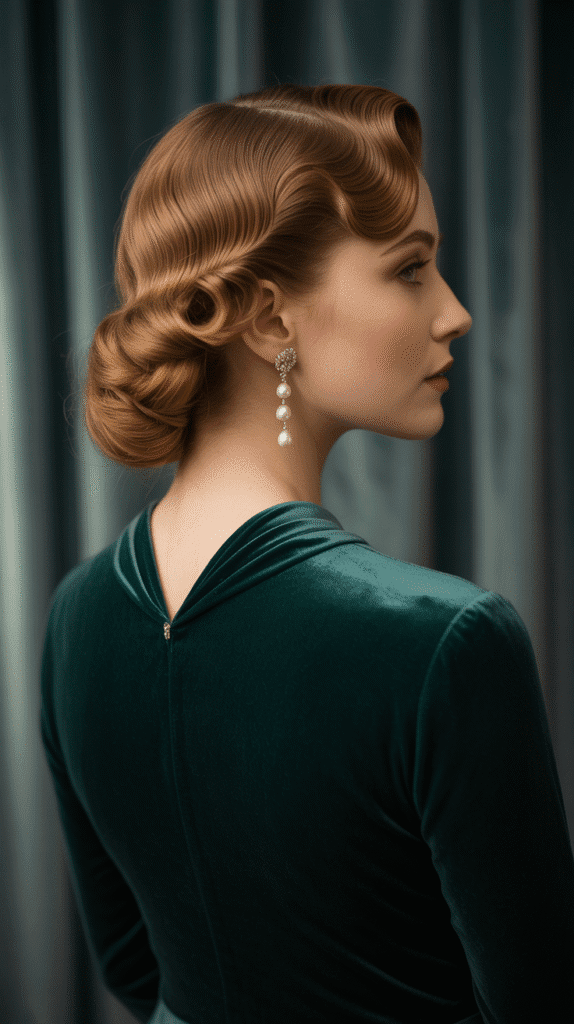
The French twist gained popularity in the 1930s as an elegant vertical updo that complemented the era’s sleek silhouettes.
Combined with finger waves at the front, this style offers sophistication suitable for the most formal occasions.
Assembly:
- Style the front section with finger waves, setting them completely before proceeding.
- Smooth the remaining hair straight back from the crown using a paddle brush and strong-hold product.
- Gather hair at the center back and hold it vertically while combing smooth.
- Twist the gathered hair upward and inward, creating a vertical roll along the center back.
- Tuck the ends into the twist and secure with bobby pins placed vertically along the seam.
- Ensure finger waves transition smoothly into the twist without visible breaks in the style.
- Finish with firm-hold hairspray, concentrating on the twist to prevent loosening.
8. Gibson Tuck with Waves
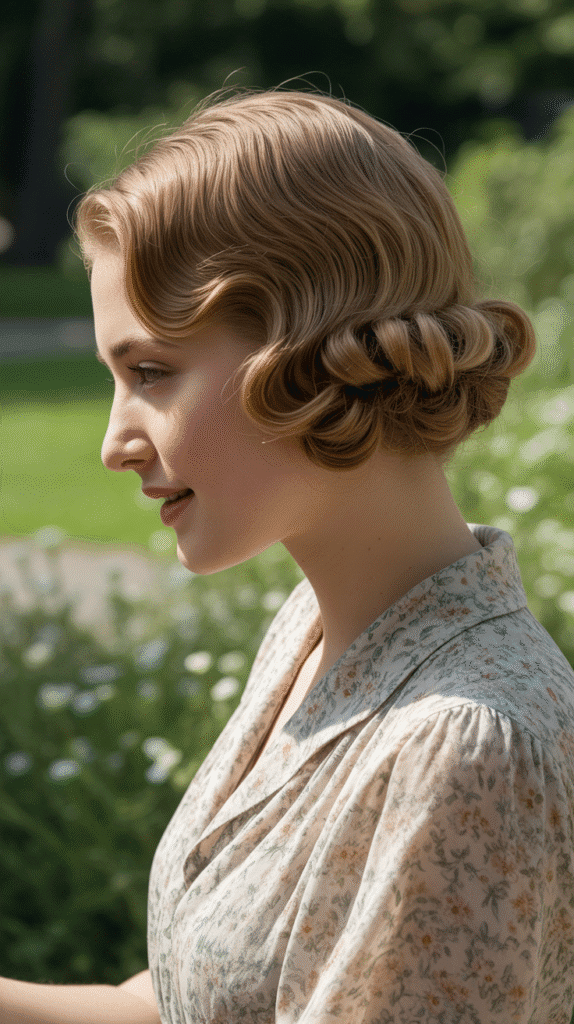
The Gibson tuck, named after illustrator Charles Dana Gibson’s drawings, features hair tucked under at the nape in a horizontal roll.
The 1930s adaptation includes waved hair for added texture and elegance.
Styling Approach:
- Set entire head in large pin curls or hot rollers to create uniform waves throughout.
- Brush through curls gently to create soft, flowing waves rather than defined ringlets.
- Section off hair at temples and crown, leaving these sections loose temporarily.
- Gather remaining hair at nape and roll it under horizontally, tucking ends underneath.
- Secure the tuck with bobby pins placed horizontally, ensuring the roll is firm and smooth.
- Arrange temple and crown sections over the Gibson tuck, pinning to conceal the rolled section.
- Finish by smoothing waves into place and securing with minimal product for natural movement.
Ideal Occasions:
- Garden weddings, afternoon tea parties, vintage photoshoots, and semi-formal daytime events.
9. Double Victory Roll with Back Twist
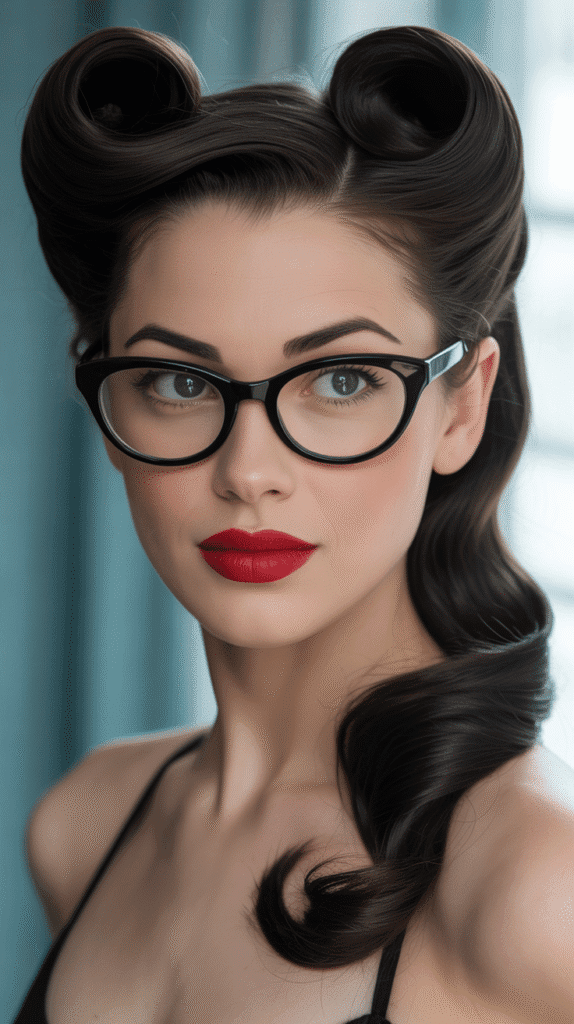
This dramatic style features two prominent victory rolls at the front with the back hair twisted into a sleek arrangement, creating maximum impact for special occasions and vintage enthusiasts.
Construction:
- Divide front hair into two equal sections on either side of the part, extending to the temples.
- Backcomb each front section generously and roll them into large, prominent victory rolls.
- Secure each roll with multiple bobby pins, ensuring they’re positioned symmetrically.
- Smooth the back section and divide it into two sections at center back.
- Twist each back section toward the center, meeting at the middle of the head.
- Cross the twists over each other and secure with pins, tucking ends under neatly.
- Apply hairspray liberally and add vintage accessories like jeweled clips at the base of the victory rolls.
10. Barrel Curl Updo
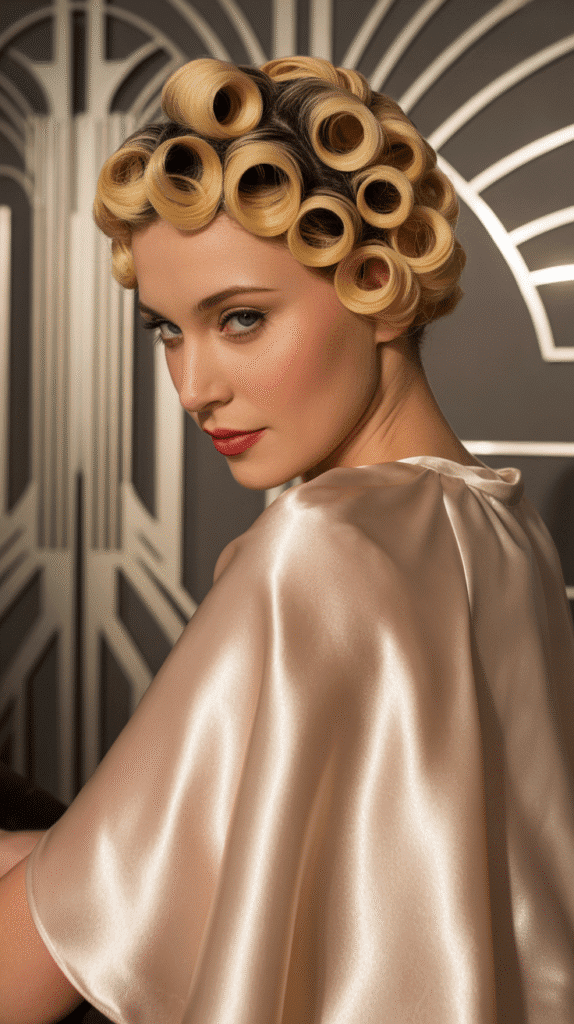
Barrel curls are large, smooth curls that create elegant volume without excessive texture.
This 1930s updo arranges barrel curls artistically around the head or clusters them at the crown for sophisticated elevation.
Setting Method:
- Use large-barrel hot rollers or jumbo flexi-rods on damp hair with setting lotion.
- Roll sections approximately two inches wide in the desired direction for curl placement.
- Allow curls to cool and set completely before carefully removing rollers without disturbing curl structure.
- Arrange individual barrel curls around the crown or sides, pinning each curl’s base to the head.
- Leave curl ends loose for dimensional texture or tuck them under for a more controlled appearance.
- Create a foundation of crisscrossed bobby pins to support the weight of arranged curls.
- Finish with flexible-hold hairspray to maintain curl definition while allowing natural movement.
11. Rolled Chignon with Side Waves
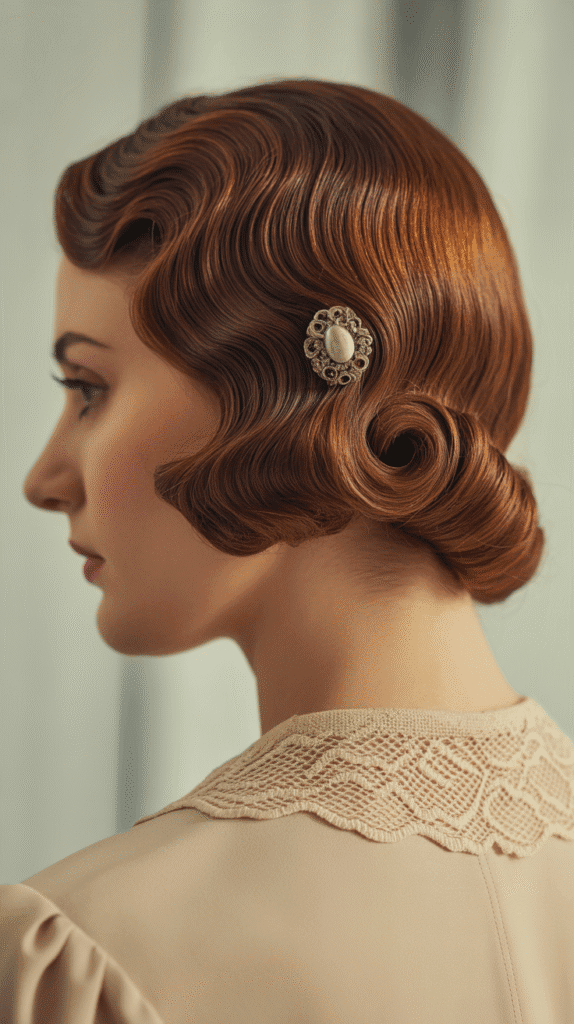
This elegant style combines side-swept waves with a rolled chignon positioned at the nape or lower back of the head.
The combination creates asymmetrical interest while maintaining classic 1930s proportions.
Process:
- Create deep waves on one side using finger wave or hot iron technique.
- Keep the opposite side smooth and sleek, using gel for high shine and control.
- Gather all hair at the desired chignon position—typically low and slightly off-center.
- Roll the hair into a horizontal cylinder, tucking ends underneath as you roll.
- Secure the rolled chignon with U-pins and bobby pins, ensuring firm attachment.
- Arrange side waves to flow gracefully into the chignon, pinning wave endpoints securely.
- Add a decorative comb or vintage brooch at the chignon’s base for authentic period detail.
12. Crown Braid Updo with Finger Waves
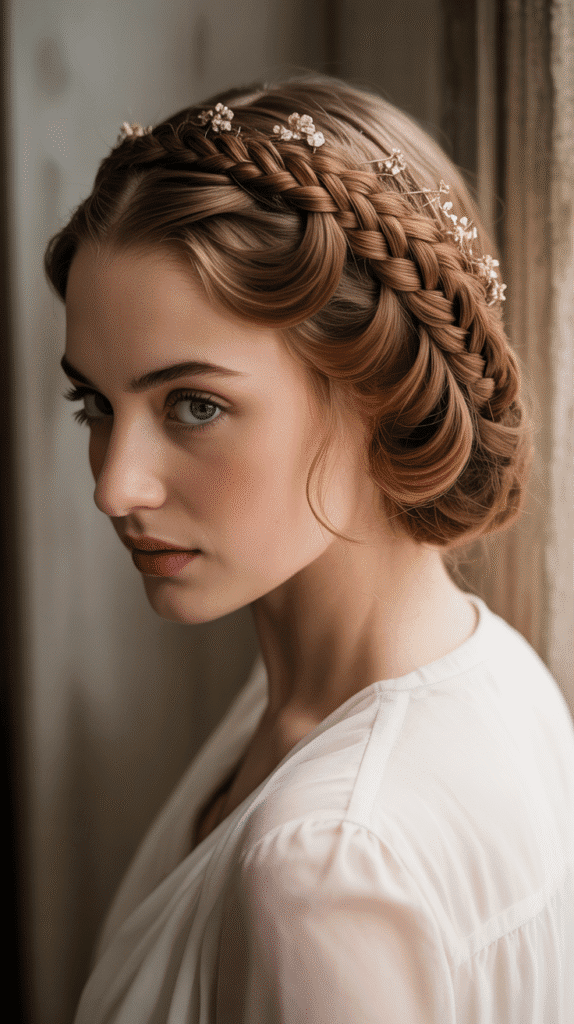
This style showcases the versatility of 1930s hairstyling by combining the structured elegance of finger waves with the romantic texture of braiding.
A crown braid encircles the head while finger waves adorn the front sections.
Assembly Instructions:
- Create finger waves across the front hairline and temple areas, setting them thoroughly.
- Part the remaining hair from ear to ear across the back of the head.
- Dutch braid or French braid the back section, working in a horseshoe pattern around the head.
- Continue braiding until all hair is incorporated, then wrap the braid around the head like a crown.
- Secure the braid end under the beginning section with bobby pins for invisible finishing.
- Ensure finger waves blend seamlessly into the crown braid at the temple connection points.
- Add small flowers or jeweled pins along the braid for enhanced vintage romance.
13. Low Side Chignon with Deep Part
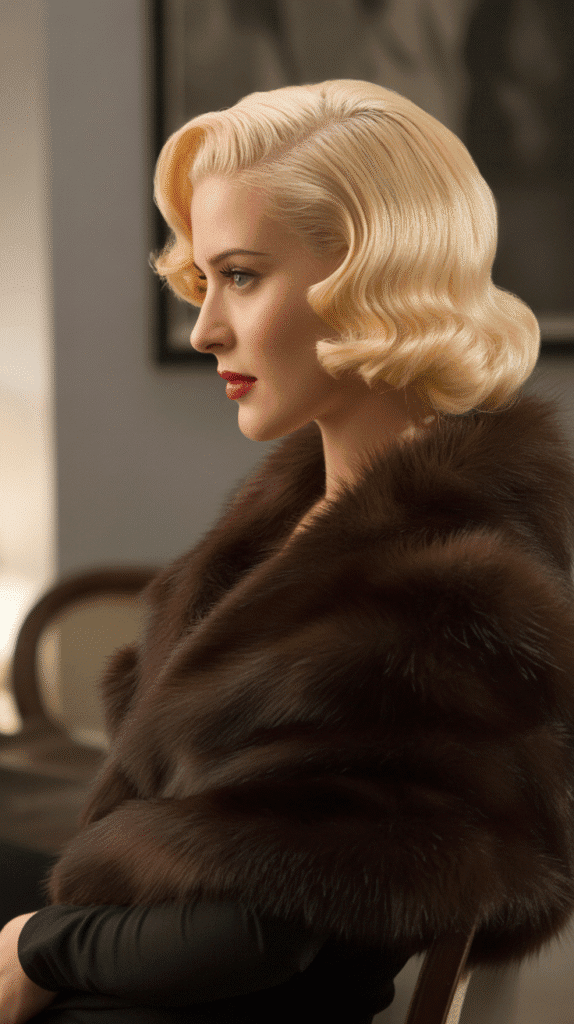
The low side chignon with deep part creates dramatic asymmetry characteristic of 1930s glamour photography.
This style works particularly well for evening events and formal occasions.
Styling Technique:
- Create an extremely deep side part, positioning it just above the temple on one side.
- Set the heavier side in large waves or smooth it straight depending on hair texture.
- Keep the lighter side ultra-sleek using strong-hold gel and a fine-toothed comb.
- Gather all hair at the nape on the side opposite the part, creating an off-center gathering point.
- Twist and coil the hair into a low, compact chignon at this gathering point.
- Secure the chignon firmly with pins, then wrap a small section of hair around the base to conceal pins.
- Finish the sleek side with glossing serum for mirror-like shine.
Hair Length Recommendation:
- Requires at least shoulder-length hair; mid-back length provides ideal volume for substantial chignon.
14. Faux Bob Updo
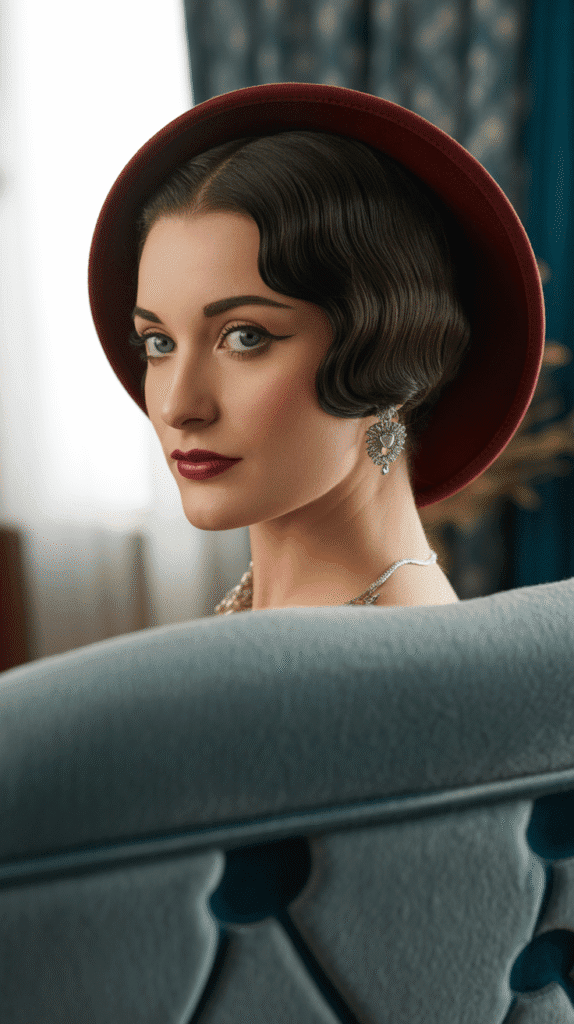
The faux bob allowed women to achieve the fashionable short bob look without cutting their long hair.
This clever technique tucks and pins long hair to create the illusion of a chin-length bob with the era’s characteristic waves.
Creation Method:
- Set hair in finger waves or pin curls throughout, allowing waves to dry completely.
- Brush through waves to create soft, connected wave patterns.
- Divide hair horizontally at the occipital bone (where head curves at back).
- Roll the bottom section upward and under, creating a horizontal roll at nape level.
- Pin the roll securely, ensuring it sits flat against the head and resembles a bob’s bottom edge.
- Arrange the top section over the rolled section, allowing waves to fall naturally to chin length.
- Pin the top section’s ends into the rolled section, tucking them invisibly underneath.
- Style the visible portions to frame the face like an authentic bob, adding finger waves at temples.
15. Sculpted Pin Curl Updo
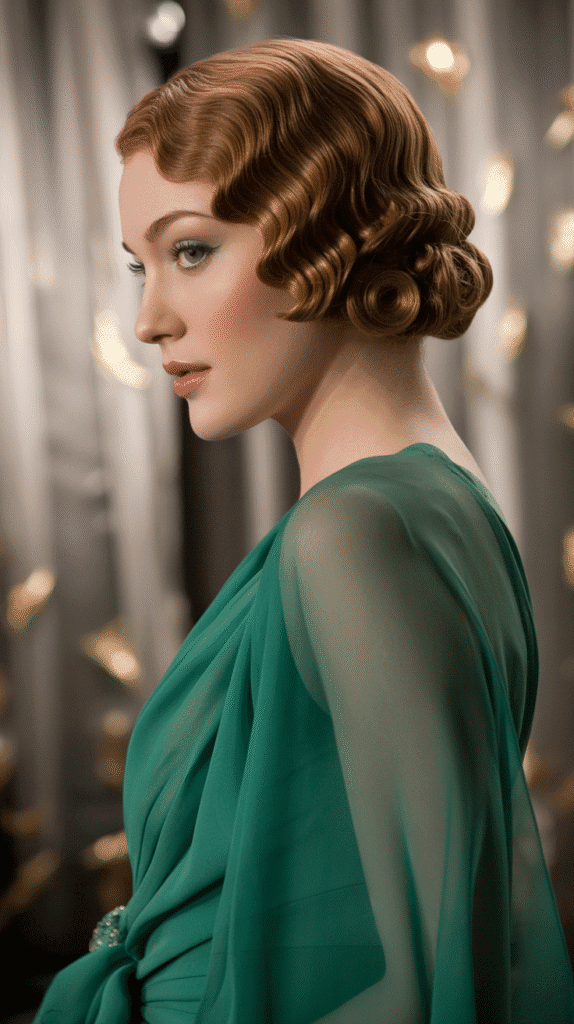
This highly structured style arranges pin curls in deliberate patterns across the entire head, creating sculptural interest and dimensional texture.
Popular for formal events, this style showcases the artistry of 1930s hairstyling.
Arrangement:
- Set entire head in pin curls of varying sizes—smaller at front, larger at back.
- Alternate curl directions in checkerboard pattern for maximum dimension and texture.
- After completely drying and removing pins, arrange curls without brushing them out.
- Position each curl deliberately, securing its base to the scalp with bobby pins.
- Create height at the crown by layering curls vertically for architectural elevation.
- Maintain curl definition by using minimal product and handling curls gently.
- Add vintage hair accessories like jeweled clips or decorative combs between curl clusters.
Durability:
- This style offers excellent longevity, lasting through long events without losing structure or definition.
16. Twisted Halo Updo
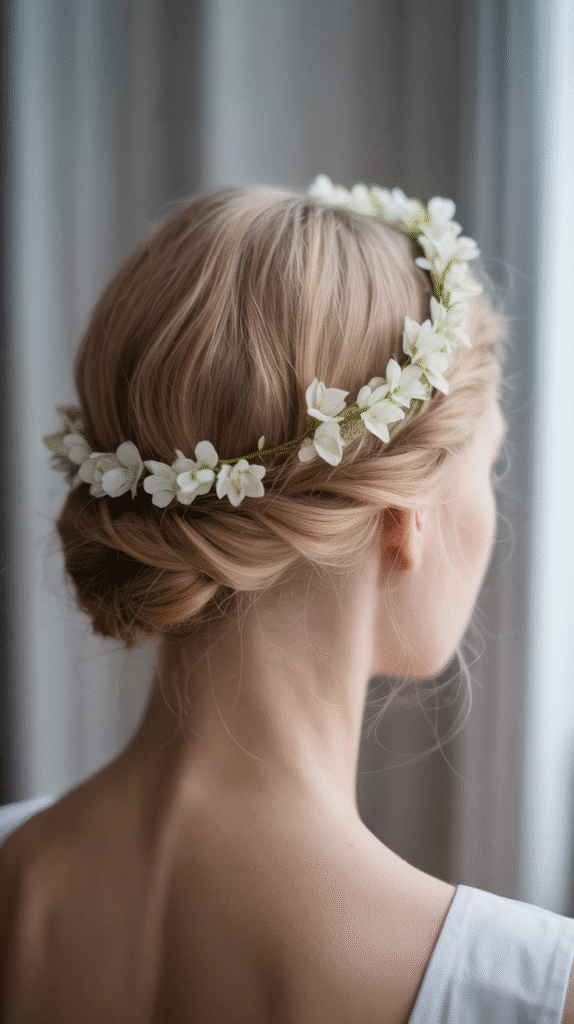
The twisted halo updo creates a crown-like effect by twisting sections of hair around the head’s perimeter.
This romantic style works beautifully for weddings and garden parties when adapted with 1930s wave techniques.
Building Process:
- Create a horizontal part from ear to ear across the top of the head, separating crown from back sections.
- Set the crown section in waves or leave it smooth depending on desired finish.
- Divide the back section into two equal parts at center back.
- Twist each back section away from the face, working upward toward the front hairline.
- Bring each twist around the head like a headband, meeting at the front center or side.
- Cross the twists over each other and secure with pins, tucking ends underneath.
- Style the crown section over the twisted halo, allowing waves to provide softness.
- Add fresh flowers, baby’s breath, or vintage hairpins throughout the halo for romantic embellishment.
17. Asymmetrical Wave and Curl Updo
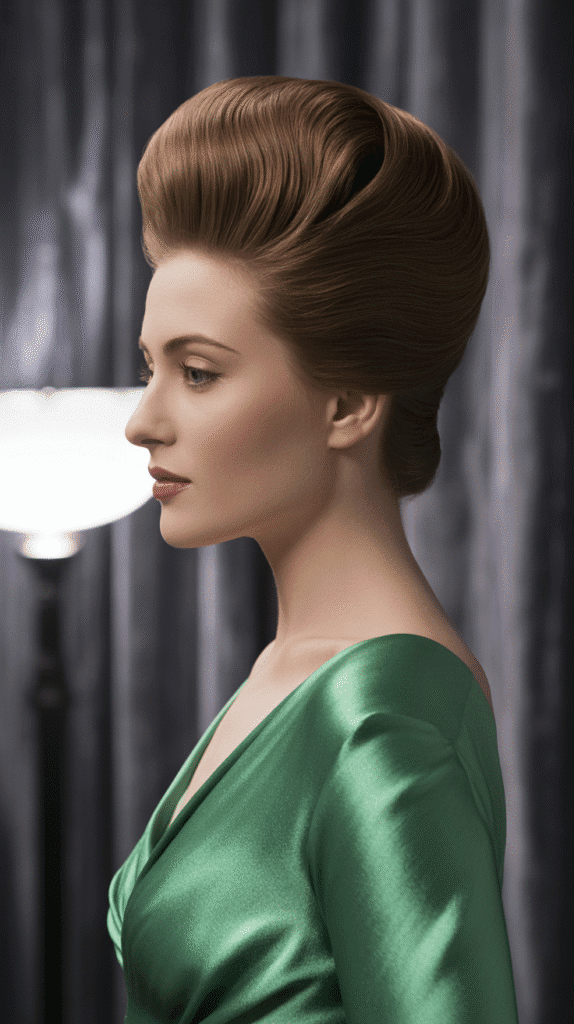
This artistic style combines waves on one side with curls on the other, creating deliberate asymmetry that was fashionable in 1930s avant-garde circles and remains striking today.
Execution Strategy:
- Divide hair into left and right sections with a center or off-center part.
- Set one side in tight finger waves, creating multiple S-curves from hairline to below ear.
- Set the opposite side in pin curls or hot roller curls for rounded texture.
- Once both sides are dry and set, brush the curled side gently to create soft ringlets.
- Leave the waved side structured and defined without brushing.
- Gather both sections at the nape, combining the contrasting textures into a unified updo.
- Create a low bun or twisted chignon that incorporates both wave and curl textures visibly.
- Secure everything firmly and finish with hairspray that maintains both texture types.
18. Vintage Pompadour Updo
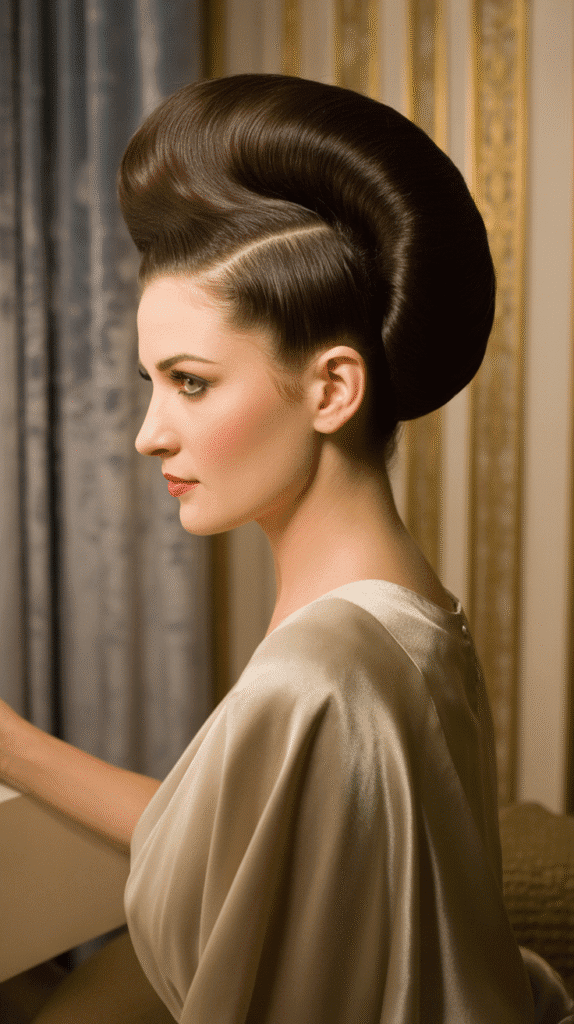
The pompadour style creates dramatic height at the front by rolling hair up and back over padding or the hair’s own volume.
This 1930s variation adds sophistication by combining the pompadour with a refined back updo.
Construction:
- Backcomb the front section extensively from mid-lengths to roots for maximum volume.
- Smooth the surface layer over the backcombed section using a natural bristle brush.
- Roll the front section up and back over the backcombed volume, creating a rounded pompadour shape.
- Secure the pompadour with bobby pins placed horizontally at its base.
- Optional: Use a hair rat or padding underneath for more dramatic height.
- Style the remaining hair into a smooth chignon, French twist, or low bun at the nape.
- Ensure the transition from pompadour to back style is smooth and well-blended.
- Finish with strong-hold hairspray, concentrating on the pompadour to maintain its height throughout the day.
19. Rolled Sides with Center Bun
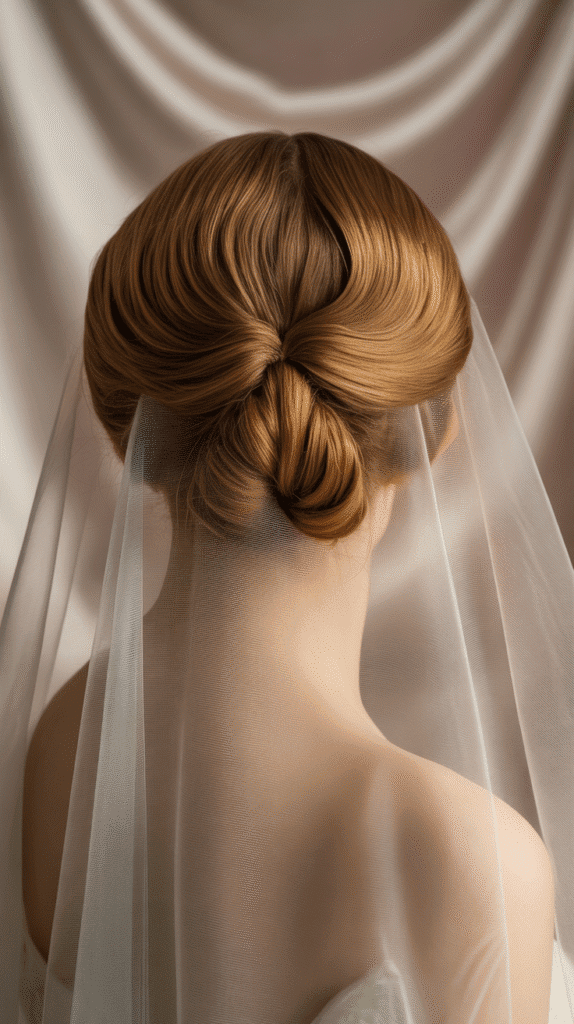
This symmetrical style features rolled sections on both sides of the head that meet at a central bun, creating balanced elegance perfect for formal occasions and vintage weddings.
Assembly Method:
- Part hair down the center from forehead to nape, creating two equal sections.
- Set each side section in waves or smooth them straight depending on desired texture.
- Starting at the front hairline, roll each side section backward toward the crown.
- Secure each rolled section with bobby pins placed vertically along the roll’s length.
- Meet both rolled sections at the crown or slightly lower at the occipital bone.
- Gather the remaining loose ends from both rolls and twist them together.
- Coil the twisted hair into a bun at the meeting point, securing it with U-pins.
- Finish by tucking any loose ends and adding decorative elements like jeweled pins or vintage combs.
20. Finger Wave Bob Updo
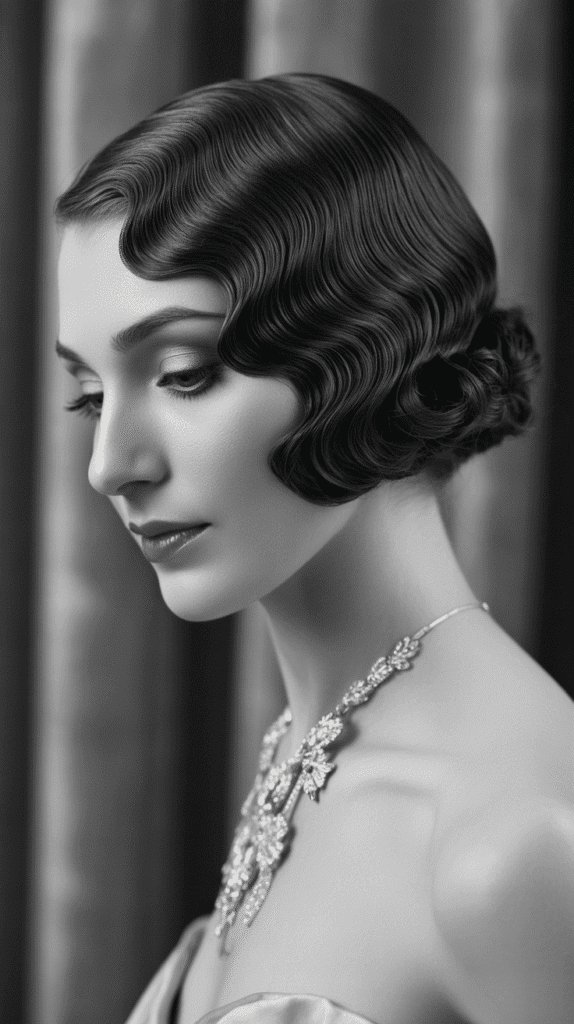
This style specifically caters to those with shoulder-length hair, creating the appearance of a finger-waved bob while actually pinning the hair up at the nape for a polished updo effect.
Styling Steps:
- Set the entire head in finger waves, working in horizontal sections from front to back.
- Ensure waves are identical in size and depth for uniform appearance.
- Allow waves to set completely, then carefully remove clips without disturbing wave formation.
- At the nape, roll the hair under horizontally, creating a foundation roll.
- Pin the roll securely, ensuring it sits at the level where a bob would naturally end.
- Arrange the waved sections to lay over the foundation roll, creating bob-length appearance.
- The sides should reach approximately chin length, while the back appears evenly bobbed.
- Finish with light hairspray to maintain wave definition without stiffness.
Perfect For:
- Those wanting to experiment with short hair aesthetics without committing to cutting length.
21. Braided Crown with Loose Curls
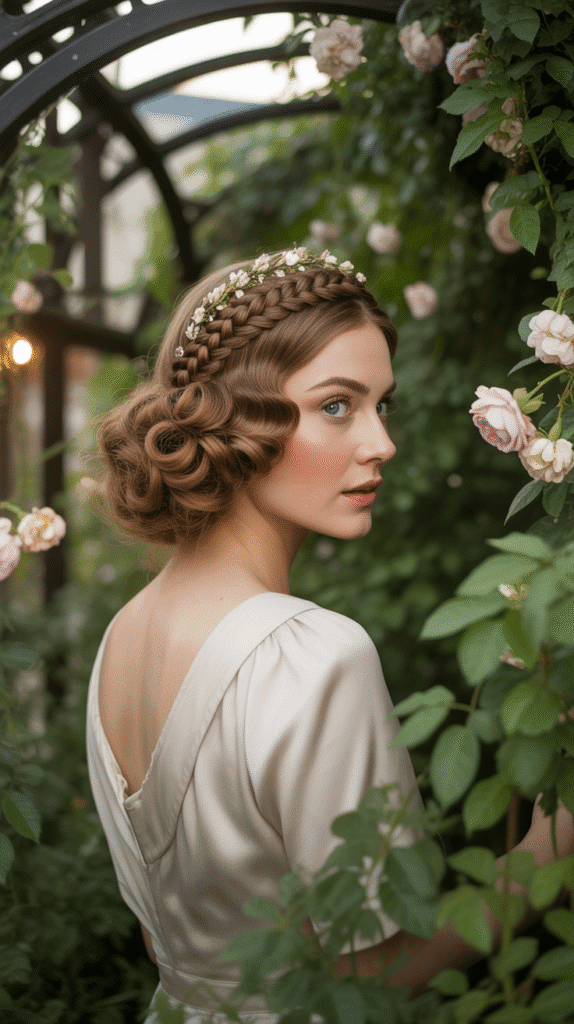
This romantic variation combines a braided crown with loose curls cascading from underneath, though adapted as an updo by pinning the curls into an arranged cluster at the back.
Creation Process:
- Create a horizontal part from ear to ear, separating the front crown section from back section.
- Braid the crown section in a Dutch or French braid from one side to the other, following the hairline.
- Secure the braid end and wrap it around the head like a crown, pinning it in place.
- Set the remaining back hair in large curls using hot rollers or curling iron.
- Once curls are cooled and set, arrange them in a cluster at the nape or lower crown.
- Pin each curl individually to create an organized yet flowing arrangement.
- Allow some curl ends to remain loose for romantic texture while securing bases firmly.
- Weave small flowers or vintage pins through the braided crown for enhanced period authenticity.
22. S-Wave Updo with Side Accent
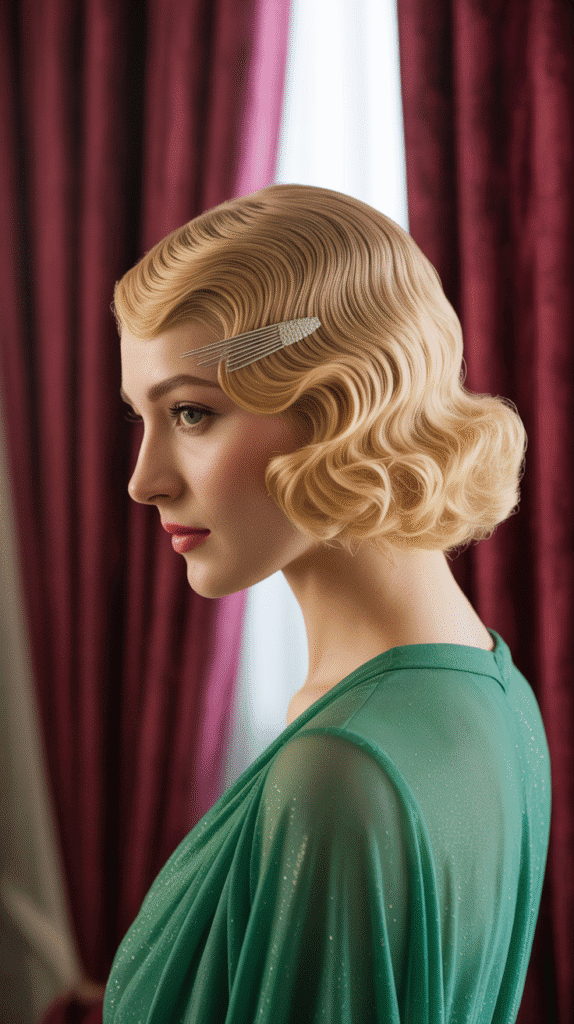
The S-wave updo features continuous S-shaped waves throughout the hair, gathered into an updo at the back with one side featuring an accent element like a decorative comb or fresh flower.
Technique:
- Apply strong-hold setting product to damp hair for maximum wave retention.
- Create S-waves using the finger wave technique throughout the entire head.
- Set waves with clips, ensuring consistent wave depth and pattern continuity.
- Once dry, remove clips carefully and assess wave uniformity.
- Gather the waved hair at the nape, maintaining wave patterns as much as possible.
- Twist or coil the hair into a low bun, allowing some wave texture to remain visible.
- On one side, position a decorative element—vintage comb, jeweled clip, or fresh flower.
- The accent should sit just above the ear, securing any loose waves into the overall style.
23. Reverse Roll Updo
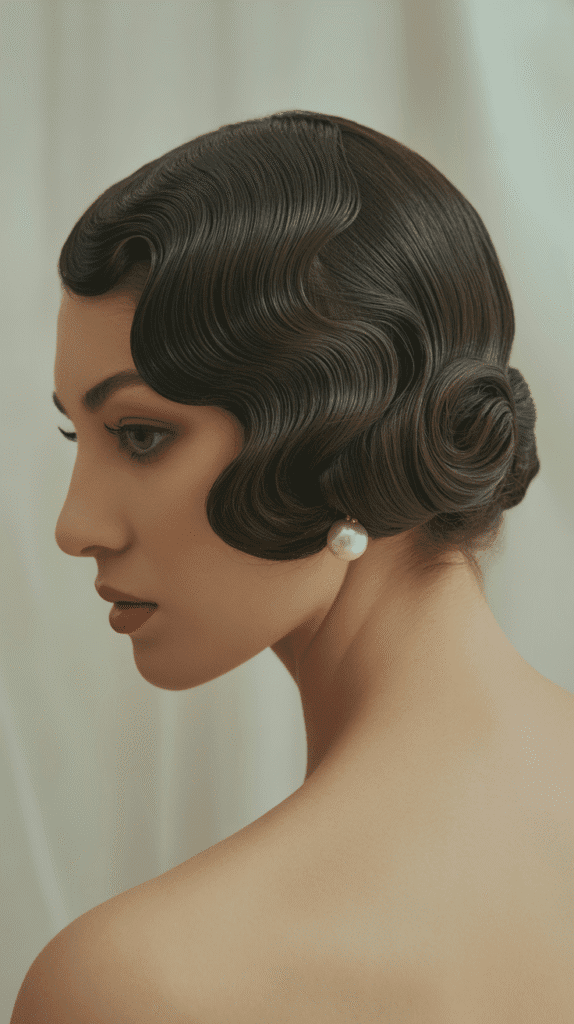
The reverse roll updo creates interest by rolling sections of hair toward the face rather than away from it, resulting in an unexpected twist on traditional rolled styles.
Building Method:
- Divide hair into horizontal sections—front, middle, and back.
- Starting with the back section, roll hair upward and forward (toward the face) instead of backward.
- Secure the reversed roll with bobby pins, ensuring it feels firm against the head.
- Roll the middle section in the same forward direction, layering it over the first roll.
- Continue with the front section, rolling it forward to meet the other rolls.
- All rolls should meet at the crown or slightly forward, creating architectural interest.
- Tuck all ends underneath the rolls for clean finishing.
- Add hairspray and smooth any stray hairs for polished completion.
Unique Appeal:
- This unconventional technique creates distinctive silhouette different from typical backward-rolled styles.
24. Nested Pin Curl Updo
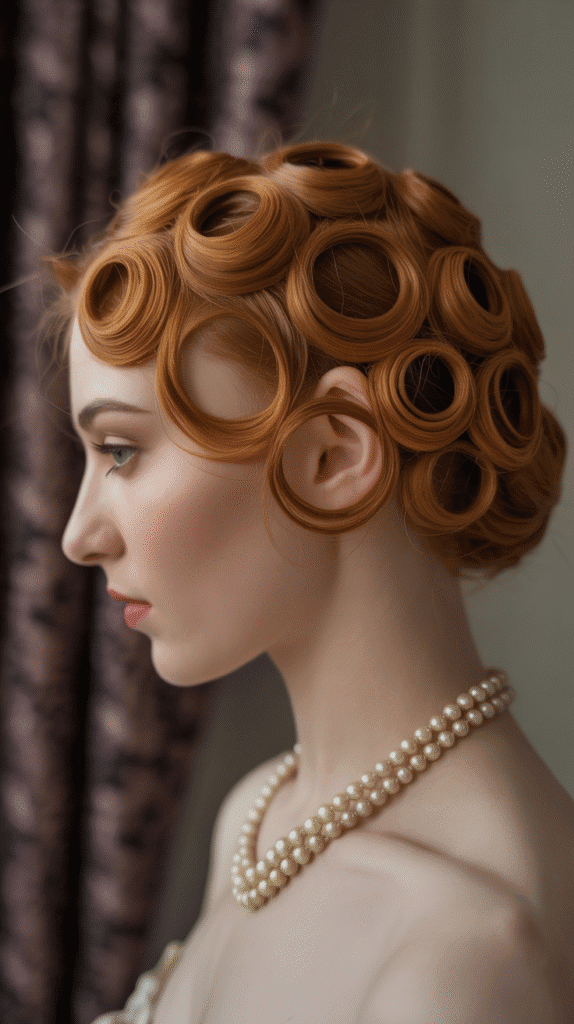
This intricate style features pin curls nested within each other, creating a rose-like pattern that showcases the meticulous artistry of 1930s hairstyling at its finest.
Advanced Construction:
- Divide hair into strategic sections where nested curl patterns will be most visible—typically sides and back.
- Create a central pin curl in each section, forming a tight spiral.
- Build subsequent pin curls around the central curl, each one slightly larger than the previous.
- Create a flower or rose-like pattern with curls radiating from the center outward.
- Set all pin curls thoroughly until completely dry.
- Remove pins carefully, maintaining the nested curl structure without separating curls.
- Arrange the nested curl patterns around the head, securing each pattern’s base to the scalp.
- Fill any gaps with smaller individual pin curls for comprehensive coverage.
- Finish with light hairspray to maintain the sculptural curl patterns.
25. Wrapped Chignon with Finger Wave Accents
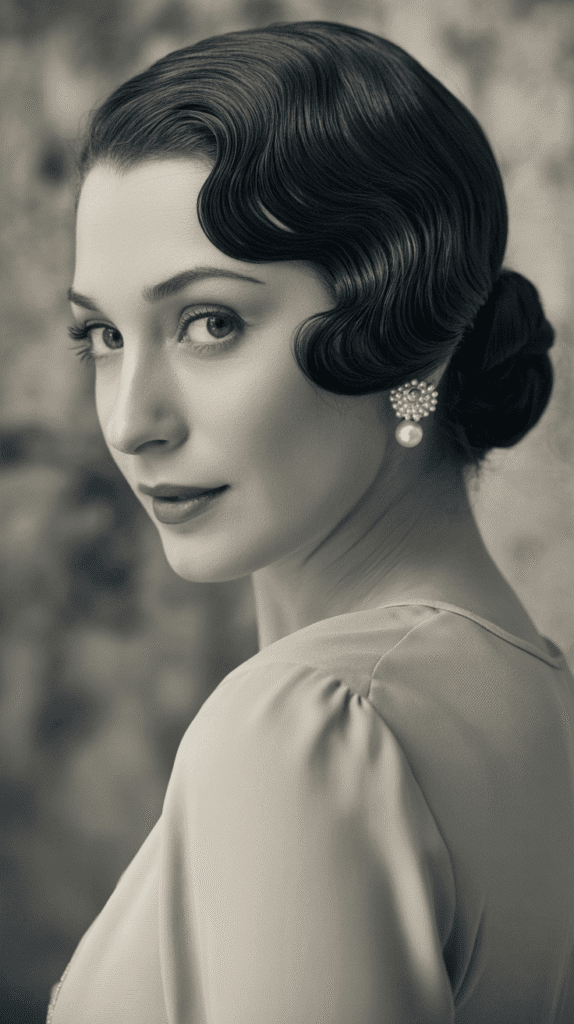
This refined style features a smooth wrapped chignon at the nape with finger wave accents at the temples or crown, combining sleek and textured elements for dimensional interest.
Styling Approach:
- Set only the front and temple sections in finger waves, leaving the back hair straight.
- Once finger waves are completely set and dry, smooth the back hair into a low ponytail.
- Divide the ponytail into two sections and twist each section individually.
- Wrap the twisted sections around each other and around the ponytail base, creating a wrapped chignon.
- Secure the chignon with U-pins and bobby pins, ensuring all ends are tucked invisibly.
- Arrange the finger wave sections to frame the face and blend into the smooth back sections.
- Use pomade or gel on the transition areas for seamless blending between textures.
- Finish with hairspray, focusing on maintaining finger wave definition.
26. Triple Roll Updo
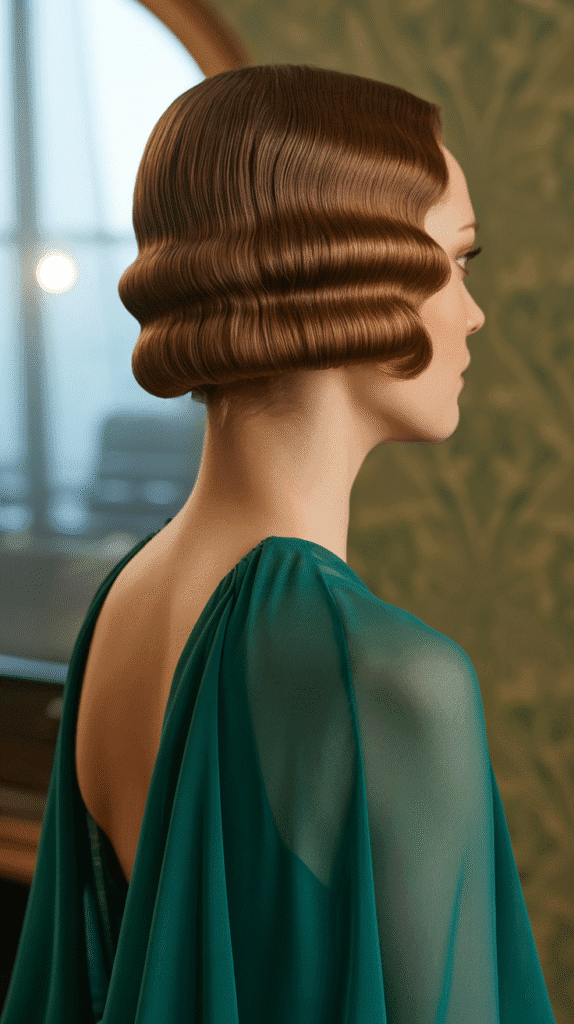
The triple roll updo creates three distinct horizontal rolls stacked vertically at the back of the head, producing a corrugated effect that was popular in formal 1930s hairstyling.
Construction Technique:
- Divide hair horizontally into three equal sections—lower, middle, and upper back sections.
- Starting with the lowest section at the nape, roll it upward and under, securing with horizontal bobby pins.
- Take the middle section and roll it in the same manner, positioning it directly above the first roll.
- Roll the top section identically, completing the stacked roll arrangement.
- Ensure each roll is the same width and positioned directly above the previous one for uniform appearance.
- Tuck all ends underneath the rolls, concealing them completely.
- Style any front sections with finger waves or smoothness to complement the rolled back.
- Secure everything with hairspray, ensuring rolls maintain their distinct separation.
27. Diagonal Wave Updo
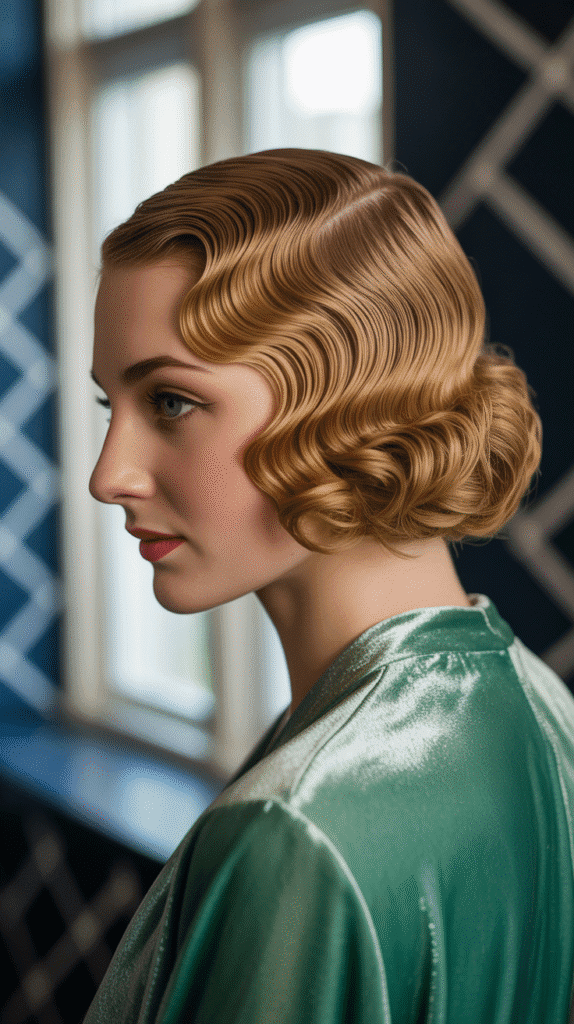
This innovative style features waves set diagonally across the head rather than horizontally, creating dynamic movement before gathering into an updo at the side or back.
Setting Method:
- Part hair in diagonal sections from one side of the forehead to the opposite side nape.
- Create finger waves following these diagonal partings, building S-curves along the diagonal lines.
- Set waves thoroughly, ensuring the diagonal direction is maintained consistently.
- Once dry and set, gather all hair at the point where the diagonal lines converge—typically at the nape or behind one ear.
- Create a bun, twisted chignon, or curl cluster at this gathering point.
- The diagonal wave pattern should remain visible and create visual interest leading to the updo.
- Secure firmly and finish with hairspray, emphasizing the unusual diagonal wave direction.
Visual Impact:
- The diagonal pattern creates illusion of movement and elongates the face shape beautifully.
28. Vintage Beehive Foundation Updo
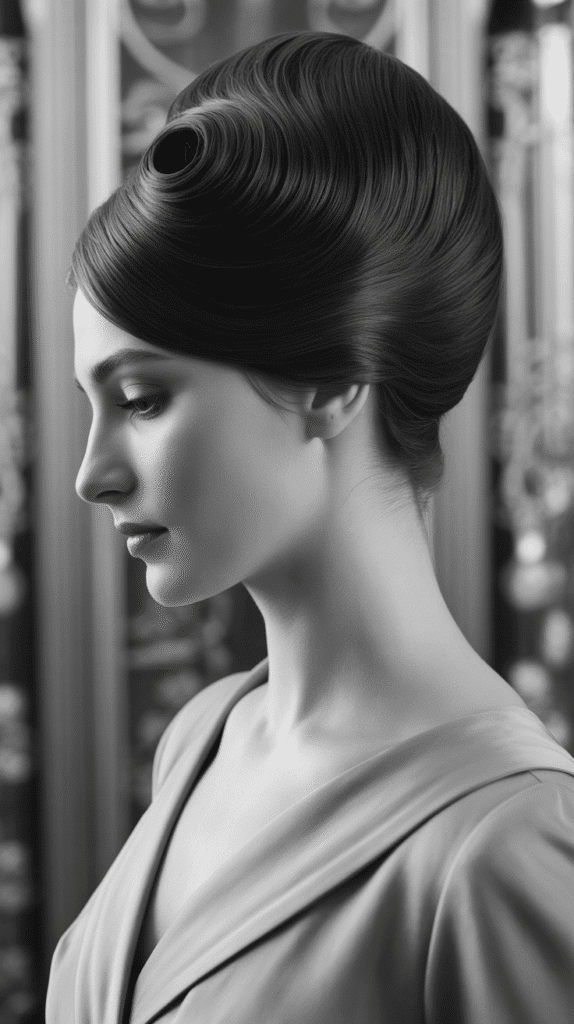
While the beehive reached peak popularity in the 1960s, its foundation technique existed in 1930s styling, creating height at the crown through backcombing and strategic pinning before finishing with smooth outer layers.
Building Process:
- Section off the crown area in a circular or square section.
- Backcomb this section intensively from mid-lengths to roots, creating substantial volume.
- Smooth the outer layer of hair over the backcombed foundation using a natural bristle brush.
- Shape the smoothed section into a rounded form at the crown, securing with bobby pins underneath.
- Gather the remaining hair at the nape and smooth it upward to meet the crown volume.
- Wrap the back hair around the base of the crown section, concealing all pins and structure.
- Create a smooth, elegant finish without visible texture on the surface.
- Add vintage accessories like jeweled combs or decorative pins at the style’s base.
29. Waved Ponytail Updo
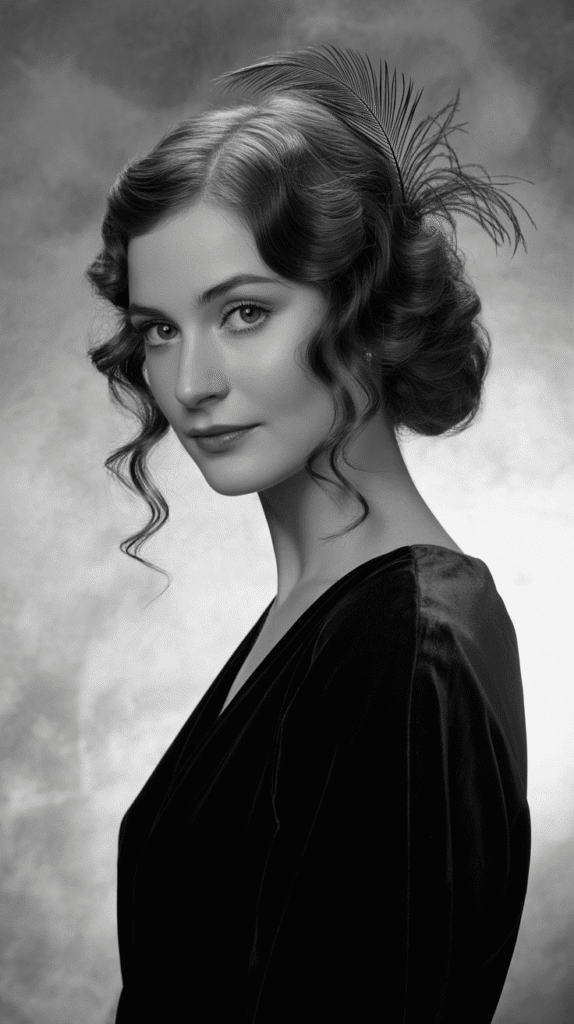
This transitional style creates a ponytail base with waved hair, then arranges the ponytail into an updo, combining the practicality of ponytails with 1930s wave elegance.
Assembly:
- Set entire head in large waves using pin curls, hot rollers, or finger waves.
- Once waves are completely set and cooled, brush through gently to create soft, connected waves.
- Gather all waved hair into a ponytail at the crown, nape, or side—wherever the finished updo should sit.
- Secure the ponytail with a hair elastic, then conceal the elastic with a small section of hair wrapped around it.
- Divide the ponytail into sections and arrange these sections around the ponytail base.
- Pin each section to create a fan, cluster, or bun arrangement that showcases the wave texture.
- Allow some wave ends to remain visible for dimensional texture.
- Finish with hairspray and add period-appropriate accessories.
30. Crossover Twist Updo
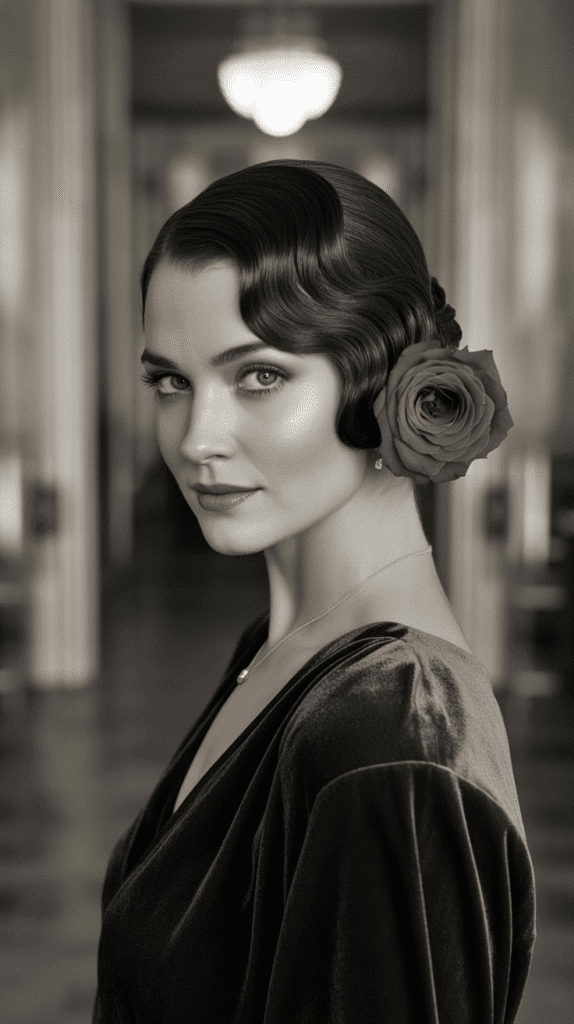
The crossover twist updo features two sections of hair twisted and crossed over each other at the back of the head, creating an X-pattern before being secured into a low bun or tucked arrangement.
Styling Instructions:
- Part hair down the center from forehead to nape, creating two equal sections.
- Smooth each section with gel or pomade for sleek, glossy finish.
- Begin twisting the left section clockwise, working from the hairline back toward the nape.
- Simultaneously twist the right section counterclockwise in the same manner.
- At the nape, cross the right twist over the left twist, creating an X-formation.
- Continue twisting both sections together after the crossover point.
- Coil the combined twisted sections into a low bun directly below the crossover.
- Secure with U-pins and bobby pins, ensuring the crossover pattern remains visible and distinct.
- Smooth any flyaways and finish with strong-hold hairspray for all-day wear.
Distinctive Feature:
- The visible X-pattern at the back creates architectural interest and showcases technical precision.
31. Cascading Pin Curl Side Updo
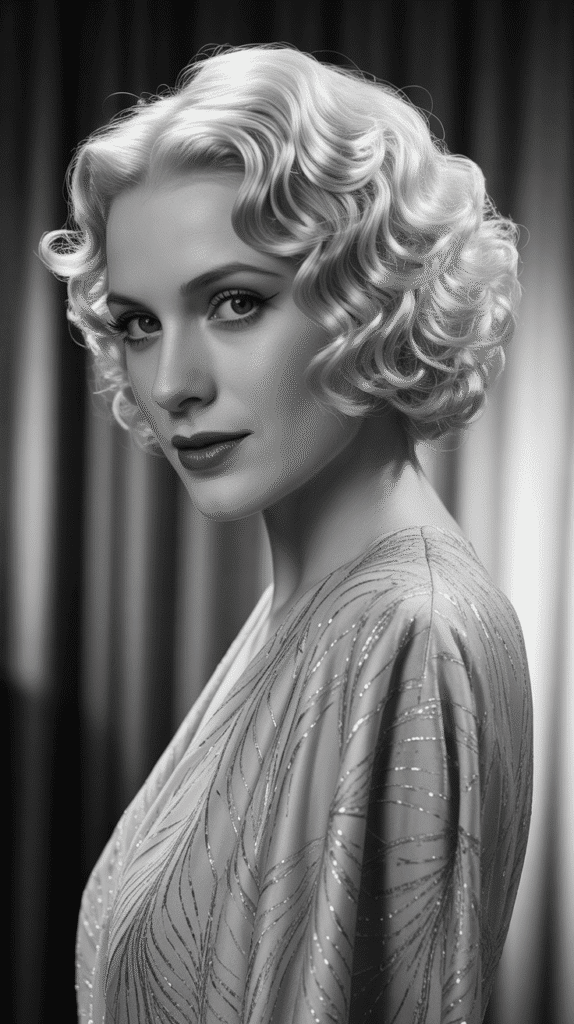
This romantic style arranges pin curls in a cascading pattern down one side of the head, creating asymmetrical elegance perfect for evening events and special occasions.
Creation Process:
- Set the entire head in pin curls, using smaller curls at the front and larger curls toward the back.
- Create a deep side part to establish the direction of the cascade.
- Once curls are completely dry and set, remove pins carefully without disturbing curl formation.
- Begin at the front on the heavier side of the part and arrange the first pin curl near the temple.
- Position subsequent pin curls in a diagonal descending line toward the opposite shoulder.
- Each pin curl should overlap slightly with the previous one, creating a connected cascade effect.
- Secure each curl’s base with bobby pins while leaving the ends loose for texture.
- On the lighter side of the part, smooth hair sleekly back and tuck it under the cascading curls.
- Add small flowers, jeweled pins, or vintage clips along the cascade for enhanced glamour.
Best Occasions:
- Evening galas, vintage weddings, prom with vintage theme, and formal photographs.
32. Rolled Pompadour with Back Cluster
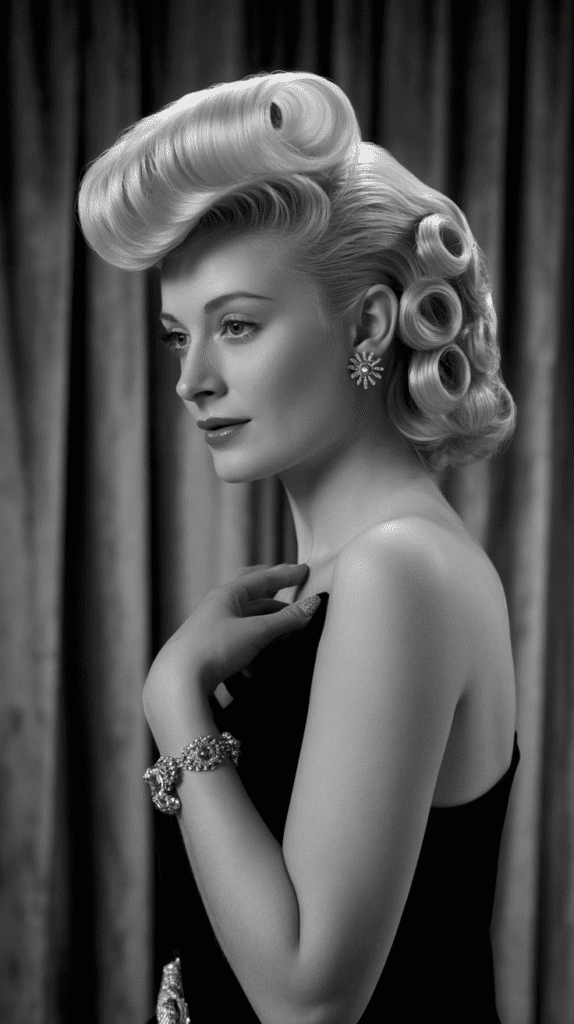
This dramatic style combines a high rolled pompadour at the front with a cluster of curls or a structured bun at the back, creating maximum height and volume characteristic of formal 1930s occasions.
Advanced Technique:
- Section off the front third of hair from ear to ear across the crown.
- Backcomb this front section extensively, creating substantial volume throughout.
- Smooth the surface layer over the backcombed section using a paddle brush.
- Roll the entire front section up and back, creating a high rounded pompadour shape.
- Secure the pompadour with multiple bobby pins placed horizontally at its base and vertically along its length.
- Set the remaining back hair in large curls or smooth it for a sleek bun.
- Arrange the back hair into a curl cluster or structured bun positioned at the crown or upper back.
- Ensure the transition between pompadour and back arrangement is smooth and well-secured.
- Apply strong-hold hairspray throughout, concentrating on the pompadour to maintain its height.
- Add decorative elements like jeweled combs at the pompadour’s base or within the back cluster.
Hair Requirements:
- Requires thick, shoulder-length or longer hair; fine hair may need padding or hair rats for adequate pompadour volume.
33. Braided Figure-Eight Updo
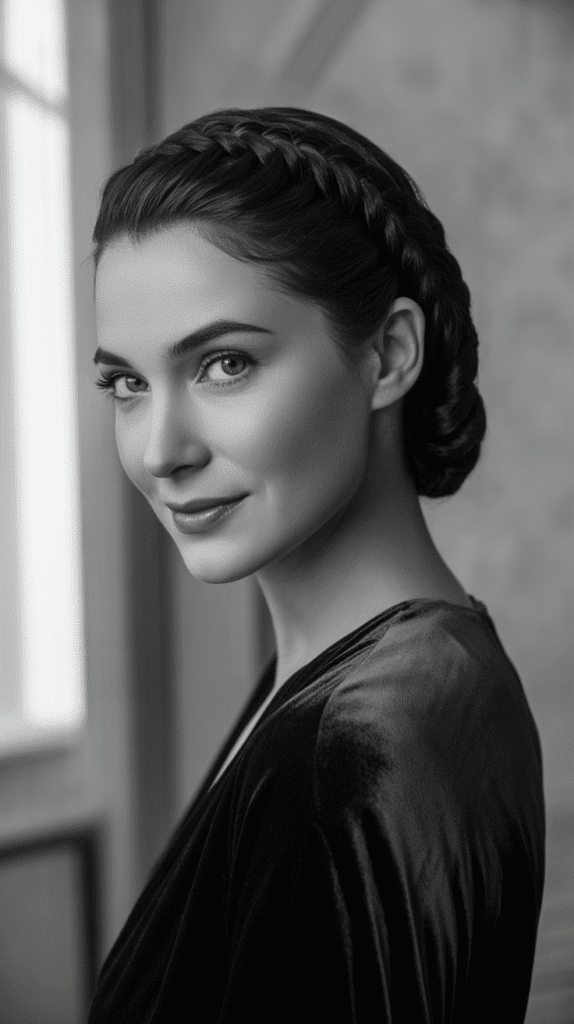
This intricate final style creates a figure-eight pattern using braided sections, combining the structure of braiding with the elegant simplicity of geometric shapes popular in 1930s design aesthetics.
Complex Assembly:
- Divide hair into two equal sections with a center part running from forehead to nape.
- Create a three-strand braid with each section, braiding down to the ends.
- Take the left braid and loop it upward and to the right, creating the top loop of a figure-eight.
- Secure the loop with bobby pins where the braid crosses itself.
- Take the right braid and loop it upward and to the left, creating the bottom loop of the figure-eight.
- Cross this braid through the center of the first loop, forming the characteristic figure-eight intersection.
- Secure both braids where they intersect at the center, ensuring the geometric pattern is clear.
- Tuck all braid ends underneath the loops, hiding them completely for clean finishing.
- Add finger waves or smooth styling to any front sections not incorporated into the braids.
- Finish with hairspray and optional decorative pins at the figure-eight’s center point.
Artistic Merit:
- This mathematically precise style showcases the intersection of geometric art deco design principles with hairstyling artistry.
Styling Tips and Product Recommendations
To successfully recreate these 33 elegant 1930s updo hairstyles, understanding proper products and techniques is essential for authentic results.
Essential Products:
- Strong-hold setting lotion or mousse provides the foundation for finger waves and pin curls that must hold their shape for extended periods.
- Pomade or hair gel with high shine creates the glossy, polished finish characteristic of 1930s styling aesthetics.
- Firm-hold hairspray ensures styles remain intact throughout long events without losing structure or definition.
- Hair nets in matching colors help secure updos invisibly while providing extra hold for intricate arrangements.
- Bobby pins in colors matching your hair are essential—purchase high-quality pins that grip firmly without slipping.
Tool Requirements:
- Finger wave clips or duckbill clips hold waves in place during the setting process without creating unwanted indentations.
- Fine-toothed combs are necessary for creating precise parts and sculpting detailed finger wave patterns.
- Natural bristle brushes smooth hair without creating static or disrupting carefully formed waves and curls.
- Hot rollers or curling irons in various barrel sizes create the different curl types needed for diverse styles.
- Hair rats or padding provide volume foundations for pompadours and other high-volume styles when natural hair is insufficient.
Technique Mastery:
- Practice finger wave techniques on a mannequin head before attempting on yourself to develop muscle memory and proper hand positioning.
- Always work with properly prepared hair—damp for setting styles, completely dry for arrangement and pinning.
- Use sectioning clips to keep unworked hair out of the way, ensuring clean lines and preventing tangles.
- Pin styles securely by creating X-formations with bobby pins rather than using single pins for maximum hold.
- Allow adequate setting time—rushing the drying process results in waves and curls that drop quickly.
Modern Adaptations:
- Heat protection spray should always be applied before using hot tools, even though this wasn’t available in the 1930s.
- Dry shampoo can be used on second-day hair to add grip and texture, making styling easier.
- Flexible-hold products allow for more natural movement while maintaining style integrity for contemporary preferences.
External Resources:
For comprehensive vintage hairstyling education, visit The Vintage Hair Academy which offers detailed tutorials on authentic 1930s techniques and modern adaptations for various hair types and lengths.
Hair Type Considerations
Different hair textures and types require specific approaches when creating 1930s updos to ensure successful results that honor the original aesthetics.
Fine Hair:
- Requires aggressive backcombing and texturizing products to create sufficient volume for structured styles.
- Benefits from hair rats, padding, or extensions to achieve the substantial updos characteristic of the era.
- Should use lightweight products to avoid weighing down hair and causing styles to collapse.
- Works exceptionally well for sleek, smooth styles like French twists and tight finger waves.
- May need more frequent pin placement to secure styles adequately throughout wear time.
Thick Hair:
- Provides natural volume but may resist wave formation without proper setting techniques and products.
- Requires longer setting times to ensure waves and curls penetrate through all hair layers.
- Benefits from sectioning hair into smaller portions when creating pin curls or finger waves for thorough setting.
- Creates substantial updos without need for padding or artificial volume enhancement.
- May need extra-strength bobby pins or U-pins to secure the weight of arranged hair.
Curly or Wavy Hair:
- Must be straightened before creating finger waves to achieve the precise S-curve patterns characteristic of 1930s styling.
- Natural texture provides excellent foundation for pin curl styles with minimal setting product needed.
- Creates fuller, more voluminous updos naturally without requiring backcombing or padding.
- Should be properly smoothed with flat iron and smoothing serum for sleek styles like French twists.
- Benefits from anti-humidity products to maintain smooth styles in challenging weather conditions.
Coarse Hair:
- Holds styles exceptionally well once properly set, with styles often lasting multiple days.
- Requires emollient-rich products to add shine and smoothness for authentic 1930s glossy finish.
- May need slightly less product than finer textures to avoid buildup or stiffness.
- Creates strong, architectural updos that maintain their shape through extended wear.
- Benefits from pre-styling treatments like hair masks to improve manageability and shine.
For detailed information about working with different hair textures in vintage styling, consult resources from Naturally Curly which provides texture-specific guidance adaptable to vintage techniques.
Occasion-Specific Styling Guide
Selecting the appropriate 1930s updo depends on the occasion, formality level, and practical considerations for the event duration and activities.
Wedding Styling:
- Brides should choose highly secure styles like French twists, wrapped chignons, or rolled updos that withstand long wear times.
- Consider veil placement when planning the updo—many styles accommodate veils beautifully at the back or crown.
- Add fresh flowers, jeweled combs, or vintage brooches that complement wedding themes and dress details.
- Schedule a trial run several weeks before the wedding to ensure style longevity and comfort.
- Bridesmaids can coordinate with complementary styles—if bride wears finger waves, bridesmaids might wear pin curls.
Formal Evening Events:
- Galas and formal dinners call for dramatic styles like sculpted pin curl updos, victory rolls, or pompadours with back arrangements.
- High shine and sleek finishing are appropriate for evening formality levels.
- Statement hair accessories like jeweled clips, decorative combs, or feather accents enhance evening glamour.
- Consider how the hairstyle complements formal gowns, jewelry, and overall aesthetic presentation.
Vintage Theme Parties:
- Great Gatsby parties demand authentic 1930s styles like finger waves, faux bobs, or Marcel wave chignons.
- Research period-appropriate accessories—headbands, cloche hats, feathers, and art deco jewelry.
- Coordinate hair and makeup for cohesive vintage looks that transport guests to the era authentically.
- Consider the party’s specific era focus—early 1930s differed from late 1930s in styling preferences.
Daytime Events:
- Garden parties, afternoon teas, and daytime weddings suit softer styles like Gibson tucks, braided crowns, or waved ponytail updos.
- Fresh flowers and natural accessories work beautifully for outdoor daytime occasions.
- Slightly less structured styles with more movement and softness feel appropriate for casual daylight settings.
- Consider weather factors—outdoor events may require extra-hold products for humidity or wind resistance.
Photography Sessions:
- Vintage photoshoots benefit from highly defined styles that read well in photographs—sharp finger waves, precise victory rolls, sculpted pin curls.
- Discuss with photographers about angles and lighting that best showcase the chosen hairstyle.
- Over-styling is acceptable for photography as cameras capture detail differently than in-person viewing.
- Black and white photography especially suits 1930s styles, emphasizing wave patterns and structural elements.
Professional/Workplace:
- Conservative updos like low chignons, French twists, or simple rolled styles work for professional settings.
- Avoid excessive accessories or overly dramatic styling that may distract in workplace environments.
- Ensure styles are secure enough to last full workdays without requiring frequent touchups.
- Professional settings may benefit from slightly more modern adaptations of 1930s techniques for contemporary appropriateness.
Maintenance and Longevity Tips
Preserving 1930s updos throughout wear time and extending their lifespan requires specific care techniques and protective measures.
During-Event Maintenance:
- Carry small emergency kit with extra bobby pins, hairspray mini, and small comb for quick touchups.
- Avoid touching or adjusting hair repeatedly as this disturbs carefully arranged elements and loosens pins.
- If styles begin to droop, strategic reapplication of hairspray to roots can revive lift and hold.
- For outdoor events, reapply anti-humidity spray periodically to combat weather effects on styled hair.
- Check mirrors periodically to catch any loosening sections before they become significant problems.
Overnight Preservation:
- Protect updos overnight by covering with silk or satin scarf to prevent friction damage.
- Sleep elevated on silk pillowcase or travel pillow to avoid crushing arranged hair.
- Some styles can last multiple days with proper nighttime protection and morning touchups.
- Pin curls can be re-formed at night to refresh wave patterns for next-day wear.
- Apply dry shampoo to roots before bed to absorb oils that might cause styles to lose hold.
Removal Process:
- Remove pins carefully, working from bottom to top to avoid pulling and damaging hair.
- Apply deep conditioning treatment after removing updos that used heavy products or extensive pinning.
- Gently detangle hair using wide-tooth comb and detangling spray before shampooing.
- Use clarifying shampoo if heavy product buildup remains after regular shampooing.
- Allow hair to rest between intensive styling sessions to prevent damage from repeated manipulation.
Product Buildup Management:
- Clarify hair weekly if frequently creating styles with heavy-hold products to prevent accumulation.
- Apple cider vinegar rinses help remove stubborn product residue while adding shine.
- Deep conditioning treatments restore moisture balance after clarifying to prevent dryness.
- Alternate between strong-hold and lighter products when possible to minimize buildup.
Extending Style Life:
- Second and third-day updos often hold better than freshly washed hair due to natural oils adding grip.
- Refresh specific sections rather than completely redoing entire styles for longer wear.
- Add dry shampoo to roots and backcomb slightly to restore lost volume on subsequent days.
- Replace loosened bobby pins with fresh pins for better hold on extended-wear styles.
- Touch up finger waves by re-setting specific sections with clips and setting spray.
Accessories and Embellishments
Authentic and reproduction 1930s accessories complete these elegant updos, adding period-appropriate finishing touches that enhance the overall vintage aesthetic.
Hair Combs:
- Decorative combs featuring art deco designs, rhinestones, or geometric patterns were essential 1930s accessories.
- Position combs at the base of updos, along rolled sections, or securing victory rolls for both function and decoration.
- Vintage reproduction combs are widely available from specialty retailers and online vintage boutiques.
- Metal combs in gold, silver, or brass tones complement various hair colors and evening wear palettes.
Jeweled Clips and Pins:
- Small jeweled clips scattered through pin curl arrangements add sparkle and vintage glamour.
- Art deco-inspired geometric designs in marcasite, rhinestones, or colored crystals remained popular throughout the 1930s.
- Placement should appear deliberate rather than random—position clips to follow wave patterns or frame curl clusters.
- Multiple small clips create more authentic period looks than single large statement pieces.
Fresh Flowers:
- Gardenias, roses, orchids, and lilies were favored 1930s choices for adorning hairstyles.
- Position flowers at updo bases, woven through braids, or tucked into pin curl arrangements.
- Use floral wire or bobby pins to secure flowers firmly without damaging delicate blooms.
- For extended wear, consider silk flowers as alternatives to fresh blooms that may wilt.
Headbands and Ribbons:
- Art deco headbands in metallics, beading, or embroidery work beautifully with certain updo styles.
- Ribbons woven through braids or wrapped around chignon bases add romantic, softer touches.
- Velvet ribbons in jewel tones complement evening looks while satin ribbons suit daytime occasions.
- Position headbands across crown or at hairline depending on overall style architecture.
Feathers:
- Ostrich feathers, peacock feathers, or decorative plumes added dramatic flair to 1930s formal hairstyles.
- Secure feathers with pins or tuck into rolled sections for secure attachment throughout wear.
- Single statement feathers create elegant simplicity while feather clusters provide theatrical drama.
- Consider event appropriateness—feathers suit evening galas but may overwhelm daytime garden parties.
Hair Nets:
- Invisible hair nets in matching colors provide security for intricate updos while remaining unseen.
- Rhinestone-studded decorative nets called snoods became popular in late 1930s as both functional and ornamental.
- Apply nets over completed updos for extra hold or use them as decorative elements over low buns.
- Vintage-style snoods are available from online retailers specializing in reproduction 1930s and 1940s accessories.
For authentic vintage accessories and reproductions, explore specialty retailers like Unique Vintage which offers extensive selections of period-appropriate hair accessories suitable for 1930s styling.
Common Mistakes and Troubleshooting
Understanding frequent errors in creating 1930s updos helps avoid frustration and achieve successful results more consistently.
Finger Wave Mistakes:
- Creating waves that are too shallow results in undefined patterns that disappear quickly—make deeper S-curves for lasting definition.
- Insufficient product application causes waves to fall flat within hours—use generous amounts of strong-hold gel.
- Removing clips before hair is completely dry ruins wave formation—always ensure 100% dryness before unclipping.
- Brushing finger waves disrupts their structure—use fingers or wide-tooth combs to gently arrange waved hair.
- Inconsistent wave depth throughout the head creates unbalanced appearance—maintain uniform wave size and spacing.
Pin Curl Problems:
- Pinning curls while still damp causes them to dry in flattened shapes—always pin completely dry curls.
- Using too-large sections results in loose, undefined curls that lack hold—keep sections one inch or smaller.
- Pulling curls apart roughly when removing pins destroys curl structure—carefully remove pins and arrange curls gently.
- Random curl direction creates chaotic texture—plan curl patterns deliberately for cohesive results.
- Insufficient setting time means curls drop quickly—allow minimum four hours or overnight for thorough setting.
Updo Security Issues:
- Using too few bobby pins results in styles that collapse or sag—use more pins than seems necessary.
- Placing pins incorrectly provides inadequate hold—create X-formations and ensure pins grip against scalp.
- Failing to create solid foundation structure causes elaborate arrangements to shift—build strong base before adding decorative elements.
- Smooth hair lacks grip for secure pinning—add dry shampoo or texturizing spray for better hold.
- Heavy hair requires U-pins in addition to bobby pins—combine pin types for maximum security.
Product Mistakes:
- Using insufficient hairspray results in styles that don’t last—apply more product than contemporary styling requires.
- Wrong product types for hair texture cause various problems—match products to specific hair needs.
- Product overload creates stiff, unnatural-looking results—find balance between hold and natural appearance.
- Applying products to wrong areas wastes product and doesn’t achieve desired effects—target products strategically.
Troubleshooting Solutions:
- If waves fall flat midway through an event, re-wet slightly with setting spray, re-form waves, and hold with clips for 10-15 minutes.
- When updos feel loose, add additional bobby pins crossed over existing pins for reinforced hold.
- If hair lacks shine, apply small amount of lightweight oil or shine spray to surface without disturbing style.
- For frizz issues, smooth with pomade applied to hands then gently pressed over styled hair.
- When styles feel too stiff, carefully mist with water from distance to soften product hold slightly.
Modern Interpretations and Adaptations
Contemporary stylists and vintage enthusiasts adapt 1930s updo techniques to suit modern preferences, creating fresh interpretations that honor historical aesthetics while accommodating current trends.
Relaxed Texture Approach:
- Modern adaptations often feature softer, less rigidly defined waves compared to authentic 1930s precision.
- Brushing through finger waves creates connected, flowing movement rather than distinct S-curves.
- Looser pin curls and deliberately pulled-apart textures provide relaxed romance for contemporary tastes.
- Combining structured elements with deliberately undone sections balances vintage inspiration with modern ease.
Color Dimension:
- Modern hair coloring techniques like balayage and highlights add dimension that enhances wave and curl patterns.
- Contemporary color choices beyond natural shades—pastels, vivid fashion colors—create unique vintage-modern fusion.
- Subtle lowlights and highlights catch light beautifully in waved and curled arrangements.
- Ombre coloring creates interesting effects when hair is arranged in layered updos.
Minimal Product Look:
- Today’s preferences often favor more natural-looking finishes rather than high-gloss shellacked appearances.
- Flexible-hold products allow movement and touchable texture while maintaining style integrity.
- Matte finish products create contemporary interpretations of vintage styles without period-typical shine.
- Balancing hold with natural appearance requires experimentation with product combinations and amounts.
Hybrid Styles:
- Combining 1930s elements like finger waves with contemporary techniques like braiding creates fresh fusion looks.
- Incorporating modern undercut styles with vintage updo toppers produces edgy vintage-inspired aesthetics.
- Blending 1930s with other decades’ signature techniques—1920s, 1940s, 1950s—creates eclectic vintage combinations.
- Adding contemporary accessories like leather bands or minimalist metals updates vintage structures for modern contexts.
Inclusive Adaptations:
- Adapting techniques for various hair textures beyond the straight European hair typical of 1930s styling imagery.
- Creating finger wave patterns on natural curly textures using twist-out or braid-out techniques.
- Modifying pin curl sizes and arrangements to accommodate different curl patterns and hair densities.
- Ensuring vintage techniques work beautifully across all hair types, lengths, and textures with appropriate modifications.
Time-Saving Modifications:
- Using hot tools to create wave patterns quickly rather than traditional time-intensive setting methods.
- Partial updos that leave some hair down reduce styling time while maintaining vintage character.
- Focusing vintage elements on most visible areas—front, sides—while keeping back sections simpler.
- Clip-in extensions or hairpieces for volume and length eliminate need for extensive styling time on natural hair.
For contemporary interpretations and styling inspiration, platforms like Pinterest and Instagram hashtags #vintagehair and #1930shairstyles showcase modern stylists’ creative adaptations of these classic techniques.
Conclusion
The timeless elegance captured in “33 Elegant 1930s Updo Hairstyles for Long Hair You Must Try” offers modern enthusiasts a gateway to the sophisticated glamour of Hollywood’s golden age.
These meticulously crafted styles—from sculptural finger waves and precise pin curls to architectural victory rolls and romantic braided arrangements—demonstrate that vintage beauty techniques remain remarkably relevant for contemporary occasions ranging from weddings and formal galas to themed celebrations and artistic photography.
Whether you’re drawn to the authentic precision of classic 1930s styling or prefer modern adaptations that blend vintage inspiration with current aesthetics, mastering these updo techniques opens creative possibilities for transforming long hair into elegant, head-turning masterpieces that honor the artistry of a defining era in beauty history while creating your own stunning interpretations for today’s special moments.Retry